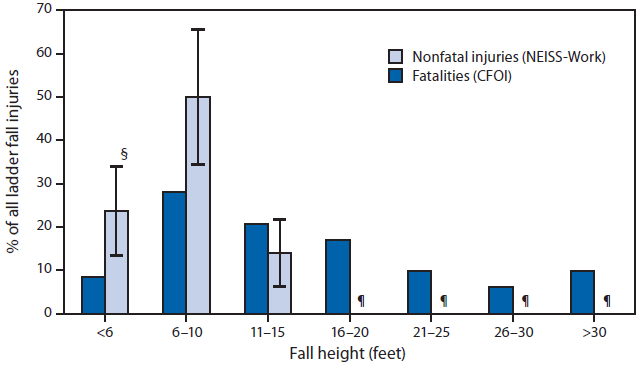MAKE-IT-SAFE MONDAY
Sometimes one of the biggest safety issues is too much confidence; thinking that you will never get hurt can often lead to cutting corners and increasing your risk of injury. Climbing ladders is one of the activities that are often a source of injury due to over-confidence.
According to the CDC, in 2011 there were 113 fatal and close to 50,000 nonfatal ladder fall injuries. These incidents occurred from fall heights of less than 6 feet to greater than 30 feet. You can see most of the height data in the graph below:
Figure taken from CDC.gov (Occupational Ladder Fall Injuries, 2011)
There are many steps you can take to keep yourself safe while using ladders. Some of the most practical steps you can take are:
- Make sure your workers are trained. This is often overlooked. No matter how confident you or your workers are about using ladders, it’s still important to step back and make sure the risks and hazards are fully understood.
- Select the Right Ladder. There are many different types of ladders for different types of situations. Ladders also have a Duty Rating, which is given to them by the manufacturer to state the maximum amount of weight that can be safely supported.
- Examine Your Surroundings/Safe Setup. Make sure you’re not setting up your ladder in a common walkway so that it’s a tripping hazard. Also, be sure to place the base of the ladder on a level, un-moveable surface. According to the American National Standards Institute, non-self-supporting ladders should be set up at an angle of 75.5 degrees to give the most amount of resistance to sliding while providing additional balance.
- Climb Slowly & Safely. Always face the ladder when climbing and maintain three points of contact at all times. You need all four of your appendages to keep you safe while climbing. Do not use one to carry something with you; use a rope or pulley system to pull up any equipment you might need. Never overextend yourself from the ladder to try to reach something. If your body extends over the side rail you can cause the ladder to fall over.
- Think Before Acting. “I can’t quite reach that nail from here, should I climb down and move the ladder a few feet over so I don’t have to overextend my reach?” Yes. “It’s getting windy, should I wait till the weather calms down to continue working?” Yes. “The ladder doesn't feel totally safe, should I climb down and double check I’m on a level and sturdy surface?” Yes. You can never be too cautious when it comes to your safety.
Too often the most common safety issues can be fixed by just slowing down, identifying potential hazards, fixing those hazards, and proceeding cautiously. We highly encourage you to take this approach when working with every aspect of your life.
Thank you for your time and attention. Let’s make it safe this Monday.
Christopher Feigal
Demand Generation Specialist, Lift’n Buddy, a Southworth Company

Thanks for your information
ReplyDeleteNebosh course in chennai
Nebosh courses in chennai
Nebosh in Chennai